As a young farmer passionate about sustainability, reducing agrochemical use has always been a priority for me. However, transitioning an entire farm overnight is unrealistic and risks crop failure. A more balanced approach is Integrated Disease Management (IDM), which combines biological, cultural, physical and chemical tools judiciously.
In this article, I'll share our experiences implementing IDM over the past few years on our diversified vegetable farm. Our goal was to minimize synthetic inputs gradually through preventative practices while retaining some as "last resort" options. With careful planning and monitoring, we've seen good results so far in reducing pesticide use by half. I hope others find our strategies and lessons helpful in their own IDM journeys.
Laying the Groundwork
The first step was assessing our entire production system holistically rather than focusing on individual crops or pests in isolation. We mapped out rotation patterns, soil health, biodiversity habitats, water sources and any problem hotspots. This revealed underlying issues like poor drainage encouraging disease buildup.
We then prioritized cultural controls - introducing beneficial plant varieties, improving rotations, applying compost regularly and planting habitat strips along field borders. These changes enhanced ecosystem services and made crops more robust naturally. Seed and transplant quality was improved to minimize disease entry points too.
Physical Barriers as the First Line of Defense
Once groundwork was laid, we turned to physical methods as the first line of defense against incoming pest pressure. Netting structures were installed around vulnerable young plants, providing an effective physical barrier against many leaf-eating insects and airborne pathogens.
For soilborne issues, drip irrigation and mulching helped maintain dry conditions unfavorable for many fungal and bacterial diseases. We also experimented with intercropping patterns minimizing microclimate suitability for pathogens. Where problems persisted, trap crops were planted as disease sinks.
These physical amendments required initial investment but paid off well. Netting lasted 3-5 seasons, saving repeated spraying costs. Drip systems improved water efficiency while disease control was a valuable co-benefit. Fewer fungicides were needed on crops grown under mulch.
Biologicals and Natural Enemies
Naturally, we sought to encourage beneficial insects, fungi and bacteria through our management. Field margins were planted with native flower mixes attracting parasitoids and predators. We also maintained small water bodies providing habitat for aquatic larvae of fungus gnats and flies - natural enemies of soilborne pests.
To aid biological control further, we inoculated compost and soils with microbes like Trichoderma and Bacillus subtilis with proven antagonistic abilities against major pathogens. Regular foliar sprays of neem, azadirachtin and other plant extracts helped boost natural plant defenses while supporting predator populations.
These interventions took time to establish but are now self-sustaining, providing an insurance policy against fluctuations in pest pressure. Disease levels reduced substantially for most crops with only minimal inputs needed from year to year.
Judicious Use of Conventional Pesticides
Despite our best efforts, occasional pest outbreaks still occurred in some seasons, especially for new crops we were trialing. Here, we relied cautiously on targeted conventional pesticides as a "break glass in case of emergency" measure rather than a routine tool.
Careful scouting and action thresholds guided application timings. We always chose the most selective options with short residual times to impact natural enemies minimally. Sprays were done in the morning or evening to avoid harming foraging beneficials. And we maintained buffer zones around field edges to protect habitats.
This approach helped control acute issues effectively without disrupting biologicals over the long term. It bought us time to further strengthen preventative strategies through adaptive management. Pesticide use decreased each year as our IDM system matured.
Monitoring is Key
No IDM plan succeeds without diligent monitoring to identify strengths or gaps for improvement. We maintained detailed records of crop health observations, beneficial and pest populations, yields and input costs. Periodic whole-farm reviews then guided modifications to our strategies.
For instance, we realized certain companion plants supported natural enemies better than others. This informed refinement of our habitat plantings. Sometimes a new pest emerged for which we hadn't anticipated, triggering proactive research into potential biological control agents.
Continuous learning also showed when an occasional chemical application was still necessary versus risks it posed. This "learning by doing" approach has been key to our IDM system's evolution matching our farm's dynamic conditions. Monitoring remains central to ongoing progress.
The Road Ahead
Of course, our journey is far from over. Emerging pests and pathogens will continue presenting new challenges under climate change. Our goal is minimizing risk through holistic ecosystem management rather than an overreliance on any single tool.
With more smallholders adopting IDM, we hope to collaborate on regional monitoring networks identifying trends proactively. Open data sharing between farms strengthens our collective understanding and resilience. Support from organizations researching biocontrol solutions also helps offset research costs for small growers.
Looking ahead, I'm excited to explore integrating precision agriculture technologies into our monitoring, from drone surveys to sensor-based scouting. When designed with farmers in mind, such tools could revolutionize pest forecasting and targeting of interventions.
In closing,
a balanced, knowledge-intensive approach like IDM is key for sustainable agriculture that's adaptive to dynamic conditions. I'm grateful for all who've walked with us on this journey so far. With open-mindedness and care for the land, I believe we can nourish people and planet for generations to come.

Post a Comment